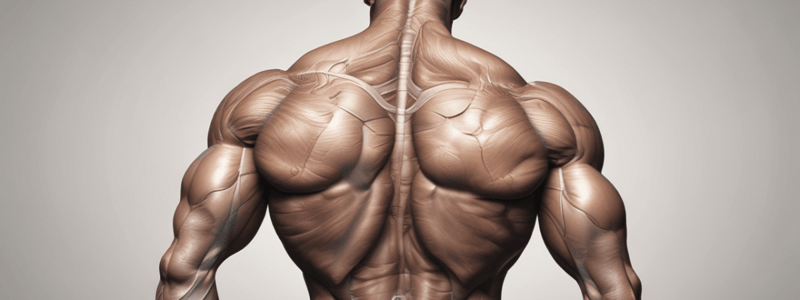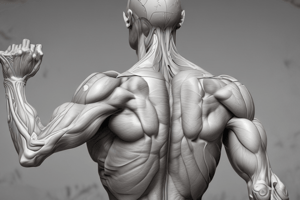Podcast
Questions and Answers
Which of the following muscles is NOT a part of the Scapulo-humeral (Intrinsic) Muscles group?
Which of the following muscles is NOT a part of the Scapulo-humeral (Intrinsic) Muscles group?
- Deltoid
- Latissimus dorsi (correct)
- Teres Major
- Rotator Cuff muscles
What is the origin of the Trapezius muscle?
What is the origin of the Trapezius muscle?
- Medial third of superior nuchal line, external occipital protuberance, and nuchal ligament (correct)
- Transverse processes of C1-C4 vertebrae
- Spinous processes of C7-T12 vertebrae
- Iliac crest, inferior 3 or 4 ribs
Which nerve is responsible for the action of the Latissimus dorsi muscle?
Which nerve is responsible for the action of the Latissimus dorsi muscle?
- Thoracodorsal Nerve (correct)
- Dorsal Scapular Nerve
- C3,4 Nerve
- Accessory Nerve
What is the insertion point of the Levator Scapulae muscle?
What is the insertion point of the Levator Scapulae muscle?
What is the action of the Levator Scapulae muscle?
What is the action of the Levator Scapulae muscle?
Which of the following muscles is a part of the Deep (Extrinsic) Muscles group?
Which of the following muscles is a part of the Deep (Extrinsic) Muscles group?
What is the origin of the Rhomboids muscle?
What is the origin of the Rhomboids muscle?
What is the origin of the Deltoid muscle?
What is the origin of the Deltoid muscle?
What is the action of the Teres Major muscle?
What is the action of the Teres Major muscle?
Which nerve innervates the Supraspinatus muscle?
Which nerve innervates the Supraspinatus muscle?
What is the action of the Infraspinatus muscle?
What is the action of the Infraspinatus muscle?
What is the insertion of the Subscapularis muscle?
What is the insertion of the Subscapularis muscle?
Which muscle is not a part of the Rotator Cuff?
Which muscle is not a part of the Rotator Cuff?
What is the origin of the Infraspinatus muscle?
What is the origin of the Infraspinatus muscle?
What is the action of the anterior part of the Deltoid muscle?
What is the action of the anterior part of the Deltoid muscle?
Study Notes
Back Muscles (Posterior Shoulder Muscles)
- Divided into three groups: superficial (extrinsic), deep (extrinsic), and scapulo-humeral (intrinsic) muscles
Superficial (Extrinsic) Muscles
- Trapezius
- Origin: medial third of superior nuchal line, external occipital protuberance, nuchal ligament, and spinous processes of C7-T12 vertebrae
- Insertion: lateral third of clavicle, acromion, and spine of scapula
- Innervation: accessory nerve (C3, C4)
- Action: acts on scapula
- Latissimus dorsi
- Origin: spinous processes of inferior 6 thoracic vertebrae, thoracolumbar fascia, iliac crest, and inferior 3 or 4 ribs
- Insertion: floor of intertubercular groove of humerus
- Innervation: thoracodorsal nerve (C6, C7, C8)
- Action: extends, adducts, and medially rotates humerus
Deep (Extrinsic) Muscles
- Levator scapulae
- Origin: transverse processes of C1-C4 vertebrae
- Insertion: medial border of scapula superior to root of spine
- Innervation: dorsal scapular nerve (C5)
- Action: elevates medial border of scapula
- Rhomboids
- Minor: origin - nuchal ligament and spinous processes of C7 and T1 vertebrae
- Minor: insertion - smooth triangular area at medial end of scapular spine
- Major: origin - spinous processes of T2-T5 vertebrae
- Major: insertion - medial border of scapula from level of spine to inferior angle
- Innervation: dorsal scapular nerve
- Action: retraction and medial rotation of scapula
Scapulo-humeral (Intrinsic) Muscles
- Deltoid
- Origin: lateral third of clavicle, acromion, and spine of scapula
- Insertion: deltoid tuberosity of humerus
- Innervation: axillary nerve (C5, C6)
- Action: anterior part - flexes and medially rotates arm, middle part - abducts arm, posterior part - extends and laterally rotates arm
- Teres Major
- Origin: posterior surface of inferior angle of scapula
- Insertion: medial lip of intertubercular groove of humerus
- Innervation: lower subscapular nerve (C5, C6)
- Action: adducts and medially rotates arm
Rotator Cuff Muscles
- Four intrinsic shoulder muscles: supraspinatus, infraspinatus, teres minor, and subscapularis
- They rotate and stabilize the shoulder joint
Rotator Cuff Muscles (Detailed)
- Supraspinatus
- Origin: superior facet of greater tubercle of humerus
- Insertion: suprascapular fossa of scapula
- Innervation: suprascapular nerve (C4, C5, C6)
- Action: initiates and assists deltoid in abduction of arm
- Infraspinatus
- Origin: middle facet of greater tubercle of humerus
- Insertion: infraspinous fossa of scapula
- Innervation: suprascapular nerve (C5, C6)
- Action: laterally rotates arm
- Teres Minor
- Origin: middle part of lateral border of scapula
- Insertion: inferior facet of greater tubercle of humerus
- Innervation: axillary nerve
- Action: laterally rotates arm
- Subscapularis
- Origin: subscapular fossa (most of anterior surface of scapula)
- Insertion: lesser tubercle of humerus
- Innervation: upper and lower subscapular nerves (C5, C6, C7)
- Action: medially rotates and adducts arm
Studying That Suits You
Use AI to generate personalized quizzes and flashcards to suit your learning preferences.
Related Documents
Description
This quiz covers the anatomy and function of the back muscles, including the superficial, deep, and scapulo-humeral muscles. Learn about the origin, insertion, innervation, and action of each muscle.



